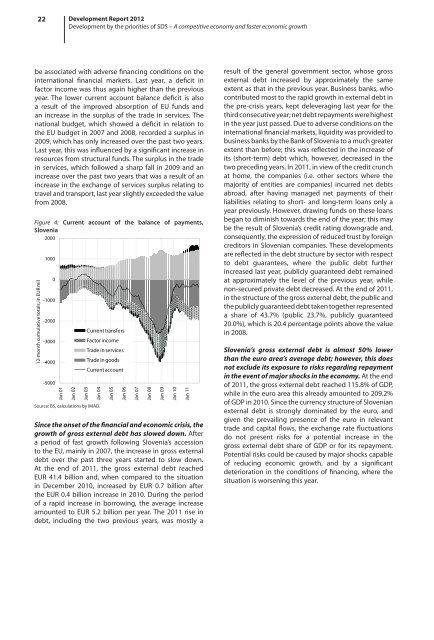development report 2012 - UMAR
development report 2012 - UMAR
development report 2012 - UMAR
Create successful ePaper yourself
Turn your PDF publications into a flip-book with our unique Google optimized e-Paper software.
22 Development Report <strong>2012</strong><br />
Development by the priorities of SDS – A competitive economy and faster economic growth<br />
be associated with adverse financing conditions on the<br />
international financial markets. Last year, a deficit in<br />
factor income was thus again higher than the previous<br />
year. The lower current account balance deficit is also<br />
a result of the improved absorption of EU funds and<br />
an increase in the surplus of the trade in services. The<br />
national budget, which showed a deficit in relation to<br />
the EU budget in 2007 and 2008, recorded a surplus in<br />
2009, which has only increased over the past two years.<br />
Last year, this was influenced by a significant increase in<br />
resources from structural funds. The surplus in the trade<br />
in services, which followed a sharp fall in 2009 and an<br />
increase over the past two years that was a result of an<br />
increase in the exchange of services surplus relating to<br />
travel and transport, last year slightly exceeded the value<br />
from 2008.<br />
Figure 4: Current account of the balance of payments,<br />
Slovenia<br />
2000<br />
12-month cumulative totals, in EUR mil<br />
1000<br />
0<br />
-1000<br />
-2000<br />
-3000<br />
-4000<br />
-5000<br />
Jan 01<br />
Jan 02<br />
Jan 03<br />
Jan 04<br />
Source: BS, calculations by IMAD.<br />
Current transfers<br />
Factor income<br />
Trade in services<br />
Trade in goods<br />
Current account<br />
Jan 05<br />
Since the onset of the financial and economic crisis, the<br />
growth of gross external debt has slowed down. After<br />
a period of fast growth following Slovenia’s accession<br />
to the EU, mainly in 2007, the increase in gross external<br />
debt over the past three years started to slow down.<br />
At the end of 2011, the gross external debt reached<br />
EUR 41.4 billion and, when compared to the situation<br />
in December 2010, increased by EUR 0.7 billion after<br />
the EUR 0.4 billion increase in 2010. During the period<br />
of a rapid increase in borrowing, the average increase<br />
amounted to EUR 5.2 billion per year. The 2011 rise in<br />
debt, including the two previous years, was mostly a<br />
Jan 06<br />
Jan 07<br />
Jan 08<br />
Jan 09<br />
Jan 10<br />
Jan 11<br />
result of the general government sector, whose gross<br />
external debt increased by approximately the same<br />
extent as that in the previous year. Business banks, who<br />
contributed most to the rapid growth in external debt in<br />
the pre-crisis years, kept deleveraging last year for the<br />
third consecutive year; net debt repayments were highest<br />
in the year just passed. Due to adverse conditions on the<br />
international financial markets, liquidity was provided to<br />
business banks by the Bank of Slovenia to a much greater<br />
extent than before; this was reflected in the increase of<br />
its (short-term) debt which, however, decreased in the<br />
two preceding years. In 2011, in view of the credit crunch<br />
at home, the companies (i.e. other sectors where the<br />
majority of entities are companies) incurred net debts<br />
abroad, after having managed net payments of their<br />
liabilities relating to short- and long-term loans only a<br />
year previously. However, drawing funds on these loans<br />
began to diminish towards the end of the year; this may<br />
be the result of Slovenia’s credit rating downgrade and,<br />
consequently, the expression of reduced trust by foreign<br />
creditors in Slovenian companies. These <strong>development</strong>s<br />
are reflected in the debt structure by sector with respect<br />
to debt guarantees, where the public debt further<br />
increased last year, publicly guaranteed debt remained<br />
at approximately the level of the previous year, while<br />
non-secured private debt decreased. At the end of 2011,<br />
in the structure of the gross external debt, the public and<br />
the publicly guaranteed debt taken together represented<br />
a share of 43.7% (public 23.7%, publicly guaranteed<br />
20.0%), which is 20.4 percentage points above the value<br />
in 2008.<br />
Slovenia’s gross external debt is almost 50% lower<br />
than the euro area’s average debt; however, this does<br />
not exclude its exposure to risks regarding repayment<br />
in the event of major shocks in the economy. At the end<br />
of 2011, the gross external debt reached 115.8% of GDP,<br />
while in the euro area this already amounted to 209.2%<br />
of GDP in 2010. Since the currency structure of Slovenian<br />
external debt is strongly dominated by the euro, and<br />
given the prevailing presence of the euro in relevant<br />
trade and capital flows, the exchange rate fluctuations<br />
do not present risks for a potential increase in the<br />
gross external debt share of GDP or for its repayment.<br />
Potential risks could be caused by major shocks capable<br />
of reducing economic growth, and by a significant<br />
deterioration in the conditions of financing, where the<br />
situation is worsening this year.
















